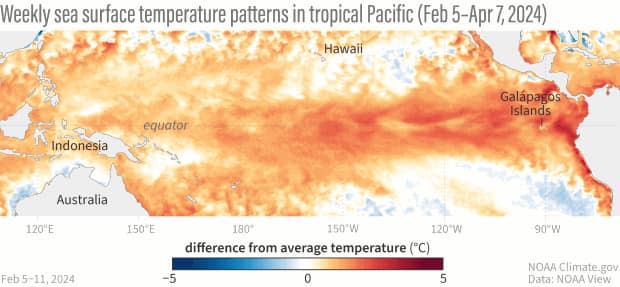El Niño is nearing its end. Does that mean global temperatures will cool down in 2024?

Last year, the planet experienced its hottest year on record. While it wasn't entirely a surprise that 2023 could top the previous hottest year — 2016 — in light of ongoing greenhouse gas emissions, what did come as a surprise was by how much.
One of the contributing factors to that extreme warmth was El Niño, a natural, cyclical warming in a region of the Pacific Ocean that, coupled with the atmosphere, can cause global temperatures to rise. Last year, it began in June.
Typically, the global atmosphere responds to El Niño in the subsequent year, which begs the question: Could 2024 be even hotter than 2023?
"Basing it on the El Niño at the beginning of the year, and then seeing how things are working out this year, it suggests that 2024 is going to be almost the same as 2023," said Gavin Schmidt, director of NASA's Goddard Institute for Space Studies in New York.

But there are a lot of other things to take into account, he said.
For example, according to the U.S. National Oceanic and Atmospheric Administration (NOAA), El Niño is coming to an end, and ocean conditions are starting to move to a neutral phase, with a 60 per cent chance that they will go into a cooling phase, called La Niña.
La Niña tends to have the opposite effect on global temperatures from El Niño, but that doesn't mean that the planet will suddenly go into a period of cooler-than-normal temperatures.
Emissions contributed to a hotter 2023
El Niño and La Niña are part of a recurring climate pattern called the El Niño-Southern Oscillation, or ENSO, that occurs roughly every seven to 10 years,
This pattern is a relatively new discovery, going back only about 60 years, so scientists don't have a lot of historical data. But they do know that not all ENSO events are equal. El Niños can be mild, strong or, as we saw in 2015-2016, extremely strong, referred to as a "super" El Niño.
Even though 2023 was not a "super" El Niño year, it ended up being hotter than 2016, and that's in part because in the eight years between the two El Niños, global temperatures have continued to climb as a result of greenhouse gases continuing to be pumped into the atmosphere.
WATCH | Is El Niño responsible for Montreal's 'non-winter' this year?
As well, the atmosphere is playing catch-up with already-released greenhouse gases from decades ago.
"It's almost like getting a head start in a race," said Karin Gleason, a climate scientist with NOAA. "2023 had a head start to 2015, because it was already in a different warmer neighborhood."
Other factors that may have contributed to 2023's hotter temperatures were the abnormally hot ocean temperatures and a reduction in aerosols that would normally reflect the sun's radiation back into space.
April could be last consecutive record-breaking month
What was strange about 2023, say climate scientists, was that the temperatures went off the scale beginning in June and just kept on going. This past March was the tenth consecutive month to have record-breaking temperatures, even if it was just by the smallest of margins.
"April temperatures are still above the rest of the record," Gleason said. "That's kind of like our first guess as to how the month might end ... In March, global temperature was a 100th of a degree Celsius above 2016. So we were kind of like, maybe this is the last month [of] consecutive months for a global record."
Daily Surface Air Temperature (90°S-90°N)
Even if La Niña does play out in its typical fashion, global temperatures are so warm that it may not have that much of an effect this year. Keep in mind that the hottest temperature in Canada occurred during a La Niña — in 2021.
"Even with a cooling as we might anticipate with going into a neutral phase, and then maybe entering La Niña towards the latter half of the year, it could easily still be warmer than 2016 in the first half of the year and [than] 2023 in the second half," Gleason said.
Alvaro Silva, a climate scientist with the World Meteorological Organization says that although there is some natural variability that results in some years being cooler than previous ones, the long-term trend continues to be a warming one.
"We have this background climbing that we cannot forget," he said. "We see each decade is warmer than [the] previous one."
2023 may have been a blip
At the moment, 2024 temperatures are looking to be more in line with that upward trend that climatologists are used to seeing.
"They're actually what we expect, following on from an El Niño that peaked in December," Schmidt said. "Everything is now looking much more like the old pattern that we were relying on. My intuition is that a 2023 is looking more and more like a blip."
WATCH | Coral reefs experiencing mass bleaching event:
Last week, Berkeley Earth, a non-profit, independent climate analysis organization, released its March 2024 update and forecast that 2024 had a 59 per cent chance of being the warmest year on record and a 41 per cent chance it would come in at second place.
"So far, we have already seen temperature records in different regions in South America in Africa and Asia," Silva said. "So this it is already taking place in different regions and will likely continue."
And with Canada's wildfire season already facing an early start, Canada, too, could be in for another challenging summer.


